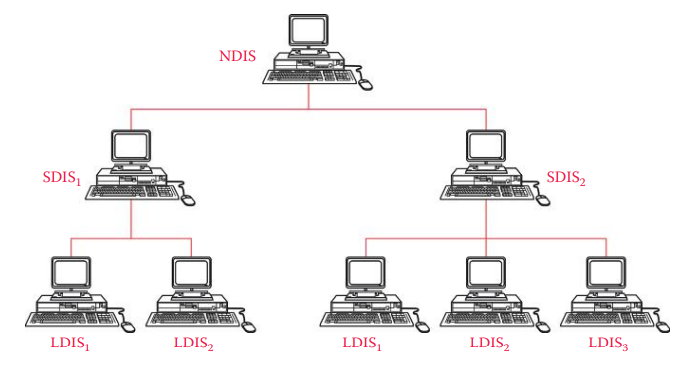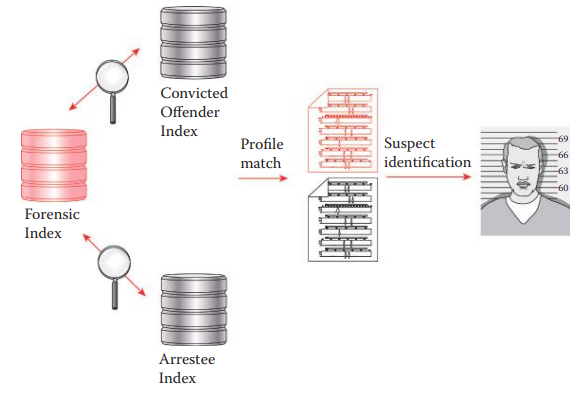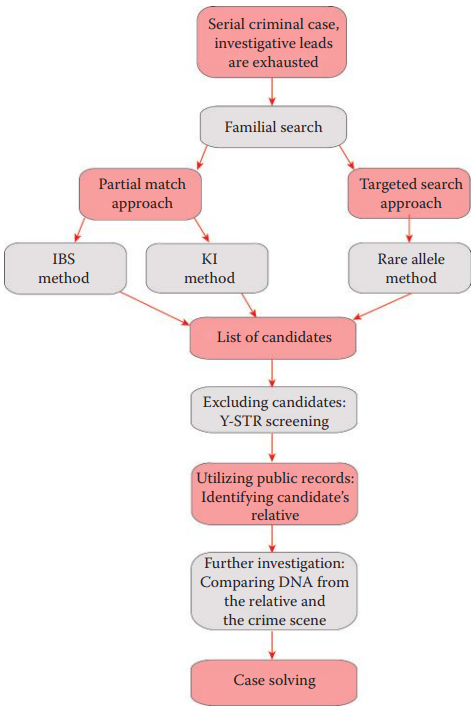Chapter 24: Forensic DNA Databases: Tools for Crime Investigation
24.1: Brief History of Forensic DNA Databases
- Forensic DNA databases: These are networks for exchanging information among law enforcement agencies to assist in solving crimes.
- National DNA Database (NDNAD): The world’s first DNA database established in United Kingdom.
- Combined DNA Index System (CODIS): Established in the USA three years after NDNAS was established.
24.2: Infrastructure of CODIS
In the United States, a pilot project of DNA databasing was initiated by the Federal Bureau of Investigation (FBI) and 14 participating state and local laboratories.
In 1994, the Congressional DNA Identification Act authorized the FBI to establish a national DNA database including “DNA identification profiles of persons convicted of crimes, and analyses of DNA samples recovered from crime scenes and from unidentified human remains.”
By 1997, 13 STR loci were selected and in 1998 were implemented as the core loci for the national database, known today as CODIS.
CODIS has three hierarchical levels:
- Local DNA Index System (LDIS): It is maintained at crime laboratories operated by police departments, sheriff’s offices, and local agencies.
- State DNA Index System (SDIS)
- National DNA Index System (NDIS)
All forensic DNA profiles originating at the local level are stored in the LDIS and are transmitted to the SDIS and NDIS.
A search through the CODIS database may be requested either from the FBI or International Criminal Police Organization (Interpol).

24.3: Indexes of CODIS
- Indexes: The DNA profiles entered in CODIS are organized into categories.
- Convicted Offender Index: It contains DNA profiles of individuals convicted of crimes.
- Arrestee Index: It contains DNA profiles of arrested individuals. It varies in SDIS databases based on each state’s law permitting the collection of DNA samples from arrestees.
- Forensic Index: It contains DNA profile derived from crime scene evidence.
- National Missing Person DNA Database (NMPDD) Program: Established by the FBI for the identification of missing and unidentified persons at the national level.
- Missing Person Index: Contains DNA profiles voluntarily contributed from relatives. This index may also store patrilineal or matrilineal DNA profiles from the relative such as a biological father, mother, or child of the missing person to assist investigations.
- Unidentified Human Remains Index: Contain DNA profiles from missing persons and unidentified human remains.
- Rapid DNA Program Office: Established by FBI for the purpose of developing rapid DNA technology.
- Rapid DNA technology: A fully automated process of performing STR analysis within 1–2 h to generate a CODIS core STR profile from a reference sample such as a buccal swab.
- Rapid DNA Index System (RDIS): The proposed index of NDIS. It shall be an integrated system capable of applying rapid DNA technology and carrying out database searches from police custody or booking units by trained police officers.
- The forensic DNA analysis of a reference sample, taken from an individual, takes 2–3 days if processed immediately in a forensic laboratory.
- Rapid DNA instruments: Are portable, compact instruments designed to be deployed into field testing. These instruments are fully automated for processing reference samples in order to generate a DNA profile in less than 2 h.
- The primary goal of the rapid DNA initiative is to produce a CODIS-compatible DNA profile of a sample taken from an arrestee in police custody and to search DNA databases during the booking process in less than 2 h.
24.4: Database Entries
- As of April 2013, CODIS contains the DNA profiles of more than 10 million convicted felons, over 1 million arrestees, and half a million crime scene samples.
- The proportion of the population represented in the database is approximately 3%.
- The NDIS is one of the largest DNA databases containing DNA profiles in terms of absolute numbers.
- Each CODIS entry consists of the DNA profile of the sample and the specimen identification number, as well as the information of the laboratory submitting the DNA profile and the laboratory analyst that performed the DNA analysis.
- The entry does not include case information or the personal information of the offenders or arrestees.
- Access to CODIS profiles is restricted to criminal justice agencies for law enforcement identification purposes.
24.5: DNA Profiles
- The CODIS software supports the storage and search of DNA profiles of short tandem repeat (STR), Y chromosome STR (Y-STR), and mitochondrial DNA (mtDNA).
- Y-STR and mtDNA profiles may only be searched within NMPDD-related indexes.
- The CODIS software no longer supports searches of DNA profiles generated by restriction fragment length polymorphism (RFLP) analysis.
- The 13 core CODIS STR loci are CSF1PO, FGA, THO1, TPOX, VWA, D3S1358, D5S818, D7S820, D8S1179, D13S317, D16S539, D18S51, and D21S11.
- DNA profiles are entered into one of the indexes, such as convicted offender, arrestee, forensic, unidentified human remains, missing person, or a relative of a missing person.
- There is a minimum loci requirement for each DNA profile entering CODIS:
- 13 core CODIS loci are required for a DNA profile entering the Convicted Offender Index and the Arrestee Index;
- 13 core CODIS loci and amelogenin, a sex-typing marker, are required for a DNA profile entering the Relatives of Missing Person Index;
- At least 10 CODIS loci are required for the Forensic Index; and
- At least 8 loci and amelogenin are required for the Missing Person and Unidentified Human Remains Index.
- The DNA profiles must be generated by an accredited and audited laboratory in accordance with the FBI’s Quality Assurance Standards using approved commercially available kits.
24.6: Routine Database Searches for Forensic Investigations
The ultimate goal of the database utilization is to provide investigative leads for law enforcement in solving crimes, particularly in cases where no suspect has yet been identified.
Hit: A match made from the information provided by comparing a target DNA profile against the DNA profiles contained in the database.
There are two types of CODIS hits:
- Offender Hit: Provides the identity of a potential suspect of a crime.
- Forensic Hit: Reveals the linkage between two or more crime scenes.
Investigation-aided cases are those assisted by CODIS hits, including case-to-case matches as well as case-to-offender matches.

Case-to-Offender Searches
- Matches of profiles from the Forensic Index and the Offender Index reveal the identities of perpetrators of crimes.
- This can help in matching and comparing DNA findings from one offender to another.
Case-to-Case Searches
- A target DNA profile from a crime scene is also searched against the profiles stored in the Forensic Index of the database.
- Matches of profiles among the target profile and the profile in the Forensic Index can link separate crime scenes and aid in identifying serial offenders.
- This helps law enforcement agencies in multiple jurisdictions to coordinate their investigations and share leads.
Search Stringency and Partial Matches
- Database searches are carried out using the CODIS software with three stringency levels, which allow the search of complex forensic profiles against offender profiles.
- A high-stringency match requires an exact match in which all alleles are matched at each locus between the target and candidate profiles.
- A moderate-stringency match is a candidate match “between two single source profiles having at each locus all of the alleles of one sample represented in the other sample.”
- In a low-stringency search, both mismatches and allelic dropouts are allowed.
24.7: Familial Searches
- Familial Search: A new method of applying databases in criminal investigations; which is based on the assumption that close relatives share more alleles of DNA profiles than unrelated individuals.
Familial Search Strategies
Identity-by-state (IBS): A method that compares the number of shared alleles and loci between a target forensic profile and the offender profiles in a database but does not take into account allele frequencies.
Kinship Index (KI): A method that evaluates the familial match by comparing the probability that two DNA profiles are from related individuals to the probability that they are unrelated.
